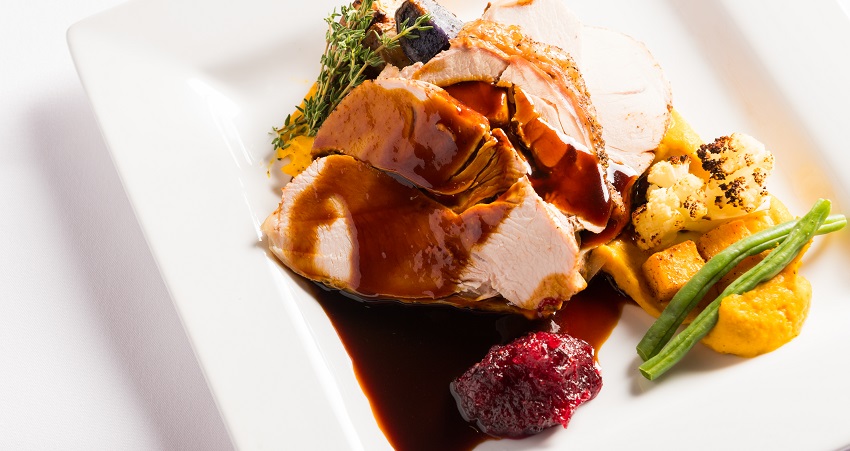Articles
November 29, 2023
Food safety tips for restaurant revelries this holiday season
Make sure your happy holidays stay that way by reinforcing safe food handling practices during the festivities.

Reminding staff of proper food safety procedures will help ensure that everyone has a happy holiday season.
As we head into the holidays, bookings for seasonal celebrations are robust, already approaching and even exceeding pre-pandemic levels in some areas. The last thing you need is a foodborne illness to ruin your customers’ holiday revelries, not to mention your restaurant’s sales and reputation. Whether a company cocktail party or a catered dinner, many of these festive events revolve around buffet service. Reminding your staff of proper food safety procedures for buffets and displays will help ensure that everyone has a happy holiday season.
“There are several holidays during the fall and winter months when folks come together—work parties, family gatherings, children’s events—and many of those involve food,” says Patrick Guzzle, vice president of Food Safety for the Association. “We all have probably experienced ‘food poisoning’ but what we might not realize is that many different microscopic pathogens can be found in our natural environment, and when conditions are just right (like leaving food out) those pathogens can multiply to levels that will make us sick.”
Foodborne pathogens aren’t the only causes of illness to watch out for, though, Guzzle says. Norovirus, a particularly nasty little bug that causes symptoms similar to “food poisoning,” is highly contagious and primarily spread through person-to-person contact. “This is especially true in closed settings,” Guzzle says, “where we all find ourselves during the colder months. Since those who are exposed can continue shedding virus particles for several days after their symptoms have resolved, norovirus can easily spread through the community even when there is no food involved.”
Here are some tips to remember to keep your patrons safe this holiday season.
Keep it clean
“There are several holidays during the fall and winter months when folks come together—work parties, family gatherings, children’s events—and many of those involve food,” says Patrick Guzzle, vice president of Food Safety for the Association. “We all have probably experienced ‘food poisoning’ but what we might not realize is that many different microscopic pathogens can be found in our natural environment, and when conditions are just right (like leaving food out) those pathogens can multiply to levels that will make us sick.”
Foodborne pathogens aren’t the only causes of illness to watch out for, though, Guzzle says. Norovirus, a particularly nasty little bug that causes symptoms similar to “food poisoning,” is highly contagious and primarily spread through person-to-person contact. “This is especially true in closed settings,” Guzzle says, “where we all find ourselves during the colder months. Since those who are exposed can continue shedding virus particles for several days after their symptoms have resolved, norovirus can easily spread through the community even when there is no food involved.”
Here are some tips to remember to keep your patrons safe this holiday season.
Keep it clean
- Start with a clean kitchen, food containers, utensils, buffet setting, and tableware.
- Protect open food displays and buffets with food shields.
- Ask employees to regularly wipe down buffets, serving areas, and food contact surfaces with food-safe sanitizing solution.
- Encourage employees to properly and frequently wash their hands.
- Keep hot foods hot and cold foods cold. Hot food should be held at 135°F or above. Make sure your fuel source, whether canned heat or electric warming, can maintain these temperatures. If you’re using canned fuel, have staff regularly check that the flame hasn’t gone out. Hold cold food at 41°F or below. Place serving containers or platters on a bed of crushed ice or use a refrigerated table.
- Have employees check food temperatures at least every two hours so you have time to correct any that aren’t within the safe zone. To ensure you’re serving your guests the best possible product, consider checking temperatures more frequently, like every half-hour.
- Use a digital probe thermometer to check your refrigerator temperature; place it in a glass of water that has been in the fridge for a few hours. Adjust the thermostat if the temperature is above 40°F.
- Replace any perishable food being held at room temperature every two hours.
- Chill leftovers properly. Put them in smaller containers and cool them from 135°F to 70°F within two hours using ice baths, wands or a blast chiller, and from 70°F to 41°F or below within four hours before placing in the refrigerator for storage. (Refrigerators are designed to keep food cold, but not to chill hot food—don’t put hot food directly into the walk-in or reach-in.)
- Prepare foods in small batches and replace batches on the buffet frequently instead of letting larger quantities sit for a long time.
- When replenishing foods, replace old serving containers with new ones. Never add new or freshly prepared food to food that has been sitting on the buffet. And don’t scrape the old batch into the new either.
- Replace used serving utensils with clean ones when replenishing food on the buffet. Size utensils for correct portioning so that guests aren’t tempted to grab a larger utensils from a nearby dish, potentially cross-contaminating dishes.
- With signage, remind customers to use new plates and utensils when getting additional helpings. Monitor the supply of fresh plates and utensils.
- Keep raw/ready-to-eat foods and cooked foods separate on the buffet.
- The only exception to the no-raw meats, poultry or seafood on a buffet is sushi and raw shellfish such as oysters; or small, ready-to-cook portions that will be eaten immediately such as sukiyaki or Mongolian barbecue; and raw, frozen, shell-on shrimp, or lobster.
- Label all food items on a buffet so guests know what they are without having to handle them (or take a taste).